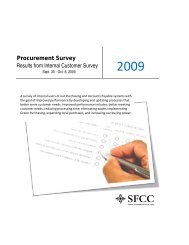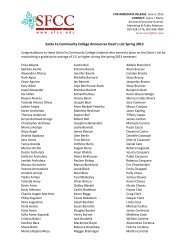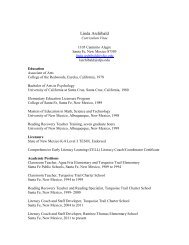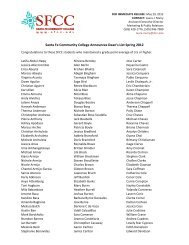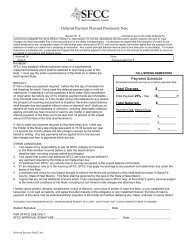Siegfried Halus
Siegfried Halus
Siegfried Halus
- No tags were found...
You also want an ePaper? Increase the reach of your titles
YUMPU automatically turns print PDFs into web optimized ePapers that Google loves.
The Body across Time: an exhibition of photography by<strong>Siegfried</strong> <strong>Halus</strong>March 27 - April 30, 2008Visual Arts Gallery HoursMonday through Friday, 10 a.m. to 5 p.m.(505) 428-1501• www.sfccnm.edu/gallerySFCC is an equal opportunity/equal access institution.Produced by SFCC’s Marketing and Public Relations Department. Feb. 2008
The Body Across Time: an exhibition of photography by<strong>Siegfried</strong> <strong>Halus</strong>The images gathered for “The Body Across Time” representthe unifying theme of <strong>Siegfried</strong> <strong>Halus</strong>’ work over almost a halfcentury: his enduring fascination with the human body. Moresignificantly perhaps, the exhibit’s title points poetically toour species’ endless fascination with its own form, its plasticpossibilities. Indeed, a good case can be made that art beganwith the human figure when Neanderthals made movingpictures of themselves by adorning their bodies with the claysof their European landscape.<strong>Halus</strong>’ selections from his “Flashlight Series” take us all theway back there. Here is a primordial landscape wrapped indarkness, lit only by bonfires that fleetingly reveal humanfigures in ostures that are clearly ritualistic – a word s ignifyinga drama so ancient we no longer recall its narrative, onlyits form.We are naked here, as once we surely were, all ourvulnerabilities exposed to rock, wind, and rain. But <strong>Halus</strong>extends the story onward with his images of draped figures.Here is the human body still, but now it is clothed in longfolds that simultaneously evoke the animal hides fashionedby our ancient ancestors; sail cloths that permitted us topopulate the whole of the planet; and burial shrouds thatwrap us for our final voyage. But more than these, thedrapings seem to symbolize that last, impenetrable mysteryof earthly existence: that radical Otherness that dividesgender from gender, race from race, neighbor from neighbor,and perhaps at last the individual from the dark forest of hisinmost being.Here then is one artist’s vision, arranged along walls so as toillustrate the chronological stages of his career. At the sametime, however, we can see in these images – and through them– the larger story, ourselves as we are, as we have become.Frederick TurnerImages:Cover:Inside front cover:Middle:Inside back cover:
The Body Across Time: an exhibition of photography by<strong>Siegfried</strong> <strong>Halus</strong>The images gathered for “The Body Across Time” representthe unifying theme of <strong>Siegfried</strong> <strong>Halus</strong>’ work over almost a halfcentury: his enduring fascination with the human body. Moresignificantly perhaps, the exhibit’s title points poetically toour species’ endless fascination with its own form, its plasticpossibilities. Indeed, a good case can be made that art beganwith the human figure when Neanderthals made movingpictures of themselves by adorning their bodies with the claysof their European landscape.<strong>Halus</strong>’ selections from his “Flashlight Series” take us all theway back there. Here is a primordial landscape wrapped indarkness, lit only by bonfires that fleetingly reveal humanfigures in ostures that are clearly ritualistic – a word s ignifyinga drama so ancient we no longer recall its narrative, onlyits form.We are naked here, as once we surely were, all ourvulnerabilities exposed to rock, wind, and rain. But <strong>Halus</strong>extends the story onward with his images of draped figures.Here is the human body still, but now it is clothed in longfolds that simultaneously evoke the animal hides fashionedby our ancient ancestors; sail cloths that permitted us topopulate the whole of the planet; and burial shrouds thatwrap us for our final voyage. But more than these, thedrapings seem to symbolize that last, impenetrable mysteryof earthly existence: that radical Otherness that dividesgender from gender, race from race, neighbor from neighbor,and perhaps at last the individual from the dark forest of hisinmost being.Here then is one artist’s vision, arranged along walls so as toillustrate the chronological stages of his career. At the sametime, however, we can see in these images – and through them– the larger story, ourselves as we are, as we have become.Frederick TurnerImages:Cover:Inside front cover:Middle:Inside back cover:
The Body Across Time: an exhibition of photography by<strong>Siegfried</strong> <strong>Halus</strong>The images gathered for “The Body Across Time” representthe unifying theme of <strong>Siegfried</strong> <strong>Halus</strong>’ work over almost a halfcentury: his enduring fascination with the human body. Moresignificantly perhaps, the exhibit’s title points poetically toour species’ endless fascination with its own form, its plasticpossibilities. Indeed, a good case can be made that art beganwith the human figure when Neanderthals made movingpictures of themselves by adorning their bodies with the claysof their European landscape.<strong>Halus</strong>’ selections from his “Flashlight Series” take us all theway back there. Here is a primordial landscape wrapped indarkness, lit only by bonfires that fleetingly reveal humanfigures in ostures that are clearly ritualistic – a word s ignifyinga drama so ancient we no longer recall its narrative, onlyits form.We are naked here, as once we surely were, all ourvulnerabilities exposed to rock, wind, and rain. But <strong>Halus</strong>extends the story onward with his images of draped figures.Here is the human body still, but now it is clothed in longfolds that simultaneously evoke the animal hides fashionedby our ancient ancestors; sail cloths that permitted us topopulate the whole of the planet; and burial shrouds thatwrap us for our final voyage. But more than these, thedrapings seem to symbolize that last, impenetrable mysteryof earthly existence: that radical Otherness that dividesgender from gender, race from race, neighbor from neighbor,and perhaps at last the individual from the dark forest of hisinmost being.Here then is one artist’s vision, arranged along walls so as toillustrate the chronological stages of his career. At the sametime, however, we can see in these images – and through them– the larger story, ourselves as we are, as we have become.Frederick TurnerImages:Cover:Inside front cover:Middle:Inside back cover:



